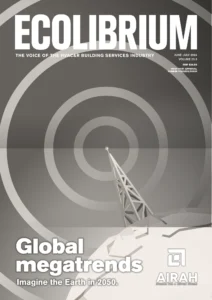
Much has been made of the poor ventilation in Australian classrooms, but the situation is even more dire for thousands of mining, construction and agriculture workers. Mark Vender investigates.
The temporary accommodation structures where many fly-in-fly-out (FIFO) workers reside, colloquially known as dongas, are notorious for elevated CO2 levels, temperature extremes, mould and condensation. As is the case in classrooms, experts point to ventilation as one of the root issues.
Defining the “donga”
Dongas are a type of prefabricated, transportable, temporary accommodation found in remote and rural areas of Australia for workers in the mining, construction, and agriculture industries. They are usually small, single-room structures with basic amenities such as a bed, table, and chairs, and are constructed from corrugated iron, steel and insulated panels. “They are ubiquitous on remote mining and construction sites all over the country, as well as in some isolated towns like Karratha and Port Hedland,” says mechanical engineer Ross Macmillan, M.AIRAH, who has been working with the structures for more than 40 years.
“In Karratha alone there are several accommodation villages, the largest of which has about 570 dongas plus several much larger mess and recreation buildings.” “Dongas are a common sight in many parts of Australia,” agrees Peter Jenkinson, Director of Outback Cleaning Products, “particularly in resource-rich areas such as Western Australia and the Northern Territory. In Australia, dongas would account for about 40,000 rooms in the mining industry, but they are also found in the accommodation industry, mainly caravan parks.”
Simple digs
A donga used for sleeping quarters generally has four single bedrooms, each with an ensuite bathroom. “They typically have a window or sliding glass door on the front and, if free standing, a rear window to the ensuite,” Jenkinson says. “If installed back-to-back, they do not have windows in the ensuites. Some do not have any openable windows, just a sliding door that is spring-loaded to force it shut.”
According to Macmillan, air conditioning is typically a 2.5kW wall split unit, with an exhaust fan in the ensuite bathroom for ventilation. Dongas are considered Class 3 buildings under the National Construction Code (NCC), which sets out ventilation requirements to provide adequate fresh air, remove pollutants, and maintain adequate indoor air quality. Under NCC clause F6D7, ventilation requirements can be met by a deemed-to-satisfy solution where “openings, windows, doors or other devices which can be opened” are a minimum of 5 per cent of the floor area of the room to be ventilated.
Macmillan says this fails to acknowledge that many dongas do not have openable windows. For those that do, the windows are not opened in hot, humid or cold weather. “In humid coastal regions, the occupants are commonly prohibited from opening windows because the internal spaces would be very quickly become overwhelmed by condensation, resulting in mould, and severe discomfort from the very high humidity,” he says. Jenkinson agrees that although the windows and doors can be opened, they rarely are.
“It has been implied that the window should be left open and the toilet door also with exhaust fan running to achieve the required ventilation,” he says, “but it is neither practical nor safe to leave windows open in hot dusty environments. In most cases windows remain closed and the required ventilation is not achieved.”
Macmillan tells of a recent visit to a village of dongas in WA that “do not have any fresh air supply, are sealed airtight, have spring closers on the sliding doors, no air relief provisions for the ensuite exhaust, and a domestic type of dehumidifier on the floor to try to control any excess humidity that inevitably leaks in”. Macmillan stayed in one of the units in the dry, winter season, and says the conditions outside were more comfortable than inside.
“The only way I could get any fresh air in the room at night was to remove the sprung door closer and leave the sliding door ajar with only the security chain on,” he says. “That would absolutely not be an option in summer, so, sorry, no fresh air for the occupants for nine months of the year.”
Condensation complication
Another issue Macmillan points to is the high relative humidity in rooms. “If there is a wall mirror in the bedroom, it fogs up and the wall linings get damp and buckle as a result,” he says. “The only way to try to get comfortable is to turn the AC temperature set-point down to 18°C and try to sleep under a doona, which creates a whole new set of problems due to interstitial condensation within the building structure.”
Macmillan says he has proposed designing suitable systems, but the camp owners are reluctant to invest. “They know the local authority will not shut them down,” he says, “even though they don’t have any provision for natural ventilation to ‘pretend’ they are NCC-compliant. “Put bluntly, none of the dongas I have inspected and stayed in over decades of working in remote areas have anything close to adequate fresh air ventilation, which makes them very uncomfortable and unhealthy to live in.”
Jenkinson highlights the elevated levels of CO2 as another major issue. Although the recommended levels are below 1,000ppm, he has taken readings above 2,300ppm. He has brought the issues to the attention of government departments, questioning WorkSafe regulations that set the maximum allowable concentration of CO2 at 5,000ppm, and that place the responsibility for opening the window on the worker to ensure adequate ventilation.
“This does not make sense,” says Jenkinson, “as opening a window in a lot of cases can cause harm by dust and heat infiltration into the occupied space.” A poll carried out with donga occupants found that only 5 per cent of respondents left the window open to bring in fresh air. Out of 273 responses, only two rooms had fresh air fans fitted. “And there was 20 per cent of people who thought that running the aircon 24/7 brings in fresh air,” says Jenkinson.
Closing the loopholes
One of the proposed changes in NCC 2025 is the inclusion of AS 1668.4 as an option for natural ventilation requirements. Jenkinson says he sees this as a step forward, but believes the loopholes need to be closed. “Dongas should be required to have a properly designed mechanical heat recovery system that can be validated, rather than relying on natural ventilation, which cannot be measured correctly or validated,” he says. “The bathroom exhaust fan system also needs to be reviewed to ensure run-on timers are fitted.”
In addition, Jenkinson advocates for stricter limits on CO2 levels. The workplace exposure standards for airborne contaminants set a limit of 5,000ppm as an eight-hour time-weighted average – Jenkinson believes this should be lowered to 1,000ppm. He also argues for providing mechanical heat recovery inlet and outlet exhaust systems to meet fresh air requirements; regular maintenance for air conditioner systems, including cleaning; the redesign of toilet exhaust systems; and control of condensation, which leads to mould growth.
Macmillan’s recommendation is more emphatic: rule out the use of natural ventilation with mechanical ventilation systems and insist on compliance with AS 1668.2. And he says this is very achievable. “The options are technically simple, low cost, energy efficient, effective, NCC-compliant by way of being AS1668.2-compliant and, most importantly of all, are guaranteed to supply a continuous flow of outdoor air for the comfort, health and amenity of the occupants year-round. “But the only way donga suppliers and camp owners will provide these systems is if they are forced to by regulation.
We must prohibit the provision of natural ventilation in air conditioned buildings, and mandate the application of AS1668.2-compliant ventilation systems – in every class of air conditioned building, not just dongas. The poor indoor quality problems our buildings are plagued with will never go away until this happens.”
Control issues
Sonia Holzheimer, M.AIRAH, is Principal Mechanical Engineer at Sequal Mechanical, and has first-hand experience of work camp accommodation. Although she agrees that issues such as spring-loaded doors and prohibiting the opening of windows must be addressed, she also argues that not all of the problems attributed to dongas are so clear cut. “While it’s widely acknowledged that living and sleeping in a donga may not be ideal, it is an overstatement to categorically label all such accommodations as ‘very’ uncomfortable and ‘unhealthy’ solely based on the aspect of natural ventilation,” she says.
And although Holzheimer applauds efforts to mandate AS1668.2-compliant ventilation systems, she believes a more nuanced approach may be warranted, especially given that natural ventilation solutions are widely used and accepted in Class 1 and Class 2 buildings. “A blanket prohibition of natural ventilation in air-conditioned buildings could have far-reaching implications for residential and commercial structures alike, potentially restricting personal choice,” she says.
Rather than dismissing natural ventilation, Holzheimer proposes stricter regulations on its use in commercial environments where individual control over environmental conditions is typically limited. “For instance, in office buildings (Class 5) or schools (Class 9), where occupants cannot usually open windows at their discretion, implementing mandatory mechanical ventilation systems could indeed be a more effective strategy for ensuring adequate indoor air quality,” she says. “
By directing our regulatory efforts toward scenarios where occupants lack autonomy over their indoor environments, we can more effectively close the ‘natural ventilation loophole.’ Adopting this targeted approach ensures that our regulations enhance health and amenity while accommodating the diverse needs and contexts of various building types.
Above all, this strategy allows everyone to maintain the ventilation solutions commonly applied in our homes.” This article first appeared on AIRAH’s HVAC&R News website, www.HVACRnews.com.au
Have your say
The public comment draft of NCC 2025 – including provisions around ventilation – is open for comment until 11.59pm AEST on July 1. Feedback can be submitted through the Australian Building Codes Board portal at www.abcb.gov.au/pcd

This article appears in Ecolibrium’s June-July 2024 edition
View the archive of previous editions
Latest edition
See everything from the latest edition of Ecolibrium, AIRAH’s official journal.





